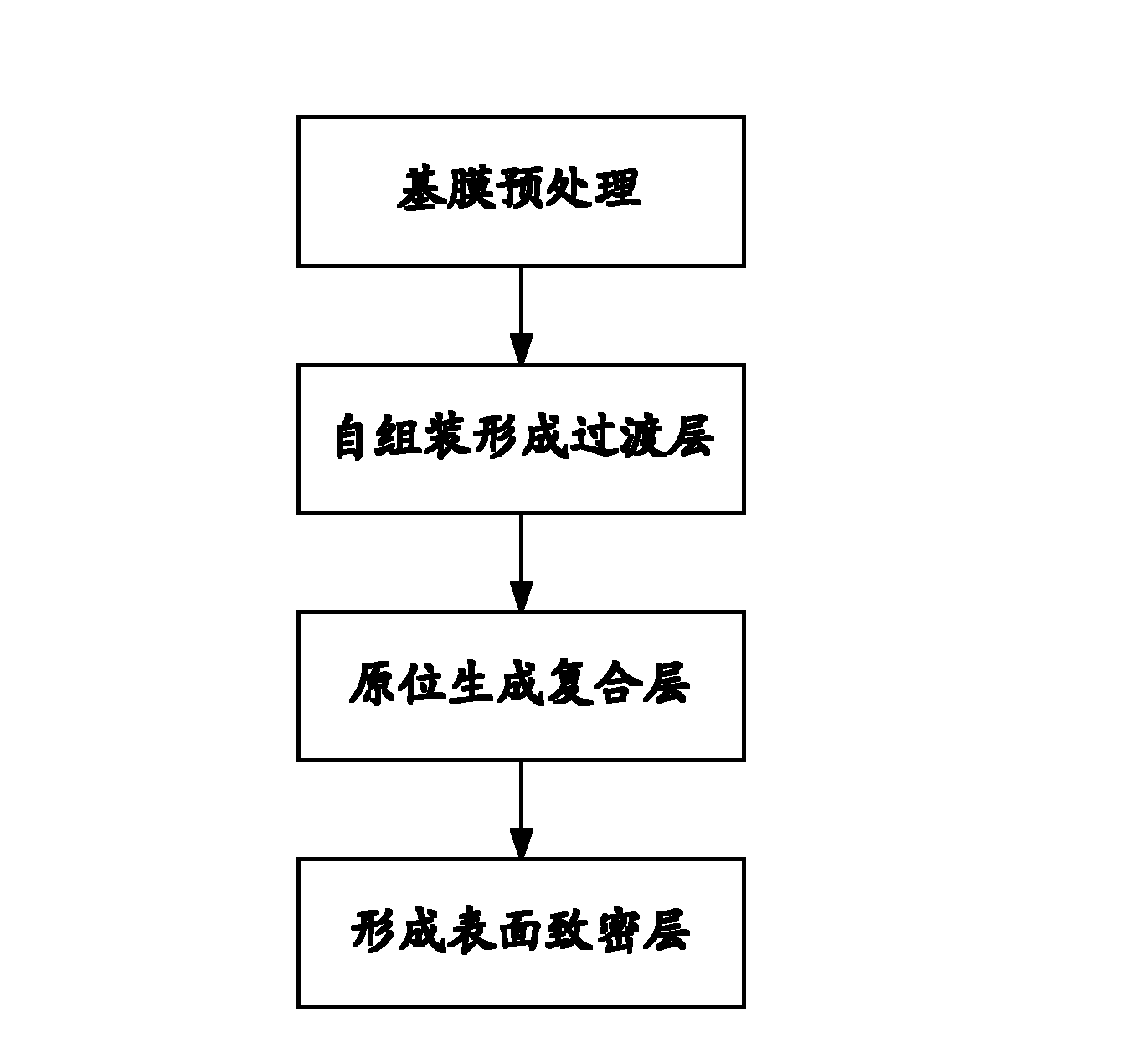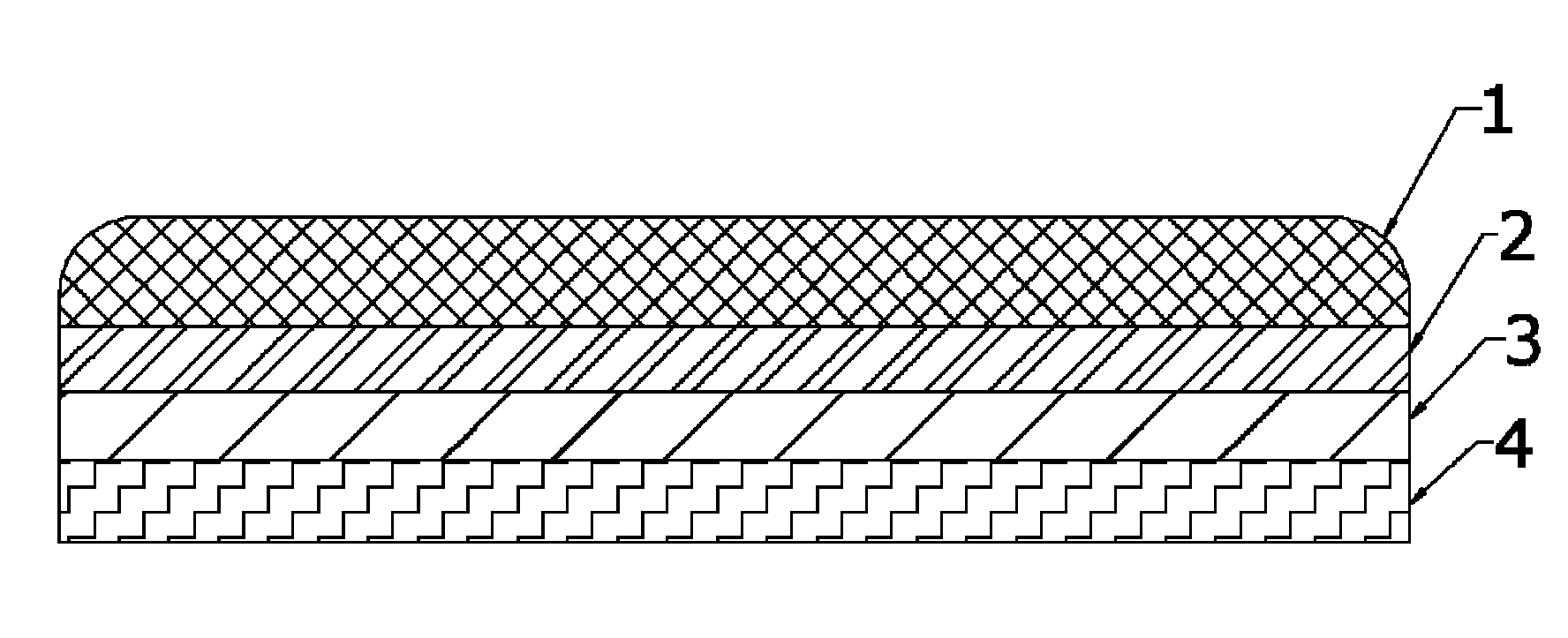Inorganic/organic composite nanofiltration membrane and preparation method thereof
A composite nanofiltration membrane, organic technology, applied in chemical instruments and methods, membrane technology, semi-permeable membrane separation, etc., can solve the problems of uneven dispersion, unstable membrane performance, etc. The effect of good separation
- Summary
- Abstract
- Description
- Claims
- Application Information
AI Technical Summary
Problems solved by technology
Method used
Image
Examples
preparation example Construction
[0023] The preparation method of the above inorganic / organic composite nanofiltration membrane, such as figure 2 As shown, the following steps are included: 1) base film pretreatment; 2) self-assembly to form a transition layer; 3) in-situ generation of a composite layer; 4) formation of a surface dense layer.
[0024] It is achieved through the following specific schemes:
[0025] 1) Pretreatment of the base membrane: Take the ultrafiltration membrane as the base membrane, treat the base membrane with 0.5-4.0 mol / L sodium hydroxide solution for 30-60 minutes, and then wash with deionized water to neutrality.
[0026] 2) Self-assembled polyelectrolyte composite membrane transition layer on the base membrane: immerse the base membrane treated in step (1) in a cationic polyelectrolyte solution of 1.0-8.0g / L, immerse it for 10-30 minutes, and then take it out with deionized water Wash thoroughly; then transfer to 1.0-8.0g / L anionic polyelectrolyte solution, make cationic polyelectroly...
Embodiment 1
[0031] 1) Pretreatment of the base membrane: Take the polyacrylonitrile ultrafiltration membrane with a molecular weight cut-off of less than 100,000 as the base membrane, treat the base membrane with 0.5 mol / L sodium hydroxide solution for 60 minutes, and then wash it with deionized water to the middle Sex.
[0032] 2) Self-assembly on the base membrane to form the transition layer of the polyelectrolyte composite membrane: the base membrane treated in step (1) is immersed in a 1.0g / L polyethyleneimine (PEI) cationic polyelectrolyte solution, and after immersing for 30 minutes, take it out for use Rinse thoroughly with deionized water; then transfer to 1.0g / L polystyrene sodium sulfonate (PSS) anionic polyelectrolyte solution, so that the cationic polyelectrolyte and anionic polyelectrolyte will form a polyelectrolyte composite layer through electrostatic action, and then rinse thoroughly , Blow dry with high purity nitrogen;
[0033] 3) In-situ generation of inorganic nanopartic...
Embodiment 2
[0037] 1) Pretreatment of base membrane: Take polyacrylonitrile ultrafiltration membrane with a molecular weight cut-off of less than 100,000 as the base membrane, treat the base membrane with a 4.0 mol / L sodium hydroxide solution for 30 minutes, and then wash it with deionized water to the middle Sex.
[0038] 2) Self-assembly on the base membrane to form the transition layer of the polyelectrolyte composite membrane: the base membrane treated in step (1) is immersed in a 8.0g / L polyethyleneimine (PEI) cationic polyelectrolyte solution, and then immersed for 10 minutes. Rinse thoroughly with deionized water; then transfer to 8.0g / L polystyrene sodium sulfonate (PSS) anionic polyelectrolyte solution, so that the cationic polyelectrolyte and anionic polyelectrolyte will form a polyelectrolyte composite layer through electrostatic action, and then rinse thoroughly , Blow dry with high purity nitrogen;
[0039] 3) In-situ generation of inorganic nanoparticles-polyelectrolyte composit...
PUM
 Login to View More
Login to View More Abstract
Description
Claims
Application Information
 Login to View More
Login to View More - R&D
- Intellectual Property
- Life Sciences
- Materials
- Tech Scout
- Unparalleled Data Quality
- Higher Quality Content
- 60% Fewer Hallucinations
Browse by: Latest US Patents, China's latest patents, Technical Efficacy Thesaurus, Application Domain, Technology Topic, Popular Technical Reports.
© 2025 PatSnap. All rights reserved.Legal|Privacy policy|Modern Slavery Act Transparency Statement|Sitemap|About US| Contact US: help@patsnap.com



